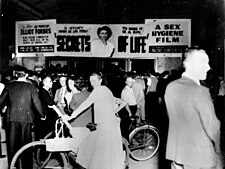
The sex hygiene film was a genre of film dealing with stories involving sexual health, particularly sexually transmitted disease (hence the slang label "clap opera"), but also sometimes touching on topics such as prostitution, birth control, and illegitimacy. The genre had its origins in the United States around the time of World War I. Early sex hygiene films were created by mainstream studios and, though their treatment of a taboo topic was controversial, they were perceived as having positive educational value. By the 1920s, sex hygiene films had begun to include graphic depictions of human anatomy, and the genre evolved into an early example of exploitation films. A 1928 article noted that there were 15 to 20 films in circulation, but that some were composed of splices from other films, whose purpose was to allow sex hygiene and medical education books to be sold in the lobby.
Sex hygiene films were publicly exhibited at theatres and often drew large audiences, though attendance was sometimes limited to adults, or to only one sex. Sometimes the promoter would have up to three versions of the film available in the theater and, upon a signal indicating that police or authorities were present, would show the more acceptable version of the film.
List of sex hygiene films
| Title | Year | Notes |
|---|---|---|
| A Victim of Sin | 1913 | The film's plot closely follows the play Damaged Goods, and was likely an attempt to capitalize on the play's success. |
| Damaged Goods | 1914 | Adaptation of the play Les Avariés written by Eugène Brieux in 1901, and performed on Broadway under the English title Damaged Goods in 1913. Richard Bennett played the lead in both the Broadway play and the film. |
| Where Are My Children? | 1916 | US film about birth control and abortion directed by Lois Weber. |
| S.O.S. | 1917 | Released by American Standard, the film follows Harold, a rakish young man who contracts venereal disease and steals away Ruth, the fiancée of his brother John. Ruth and Harold have a child who is born "a hopeless cripple and a degenerate". |
| Let There Be Light (Es werde Licht!) | 1917 | One of the first German sexual hygiene films. |
| Fit to Fight | 1918 | An anti-venereal disease film produced for the U.W. War Department Commission and initially shown to members of the military. Later re-edited and released theatrically to the public under the title Fit to Win. |
| The Spreading Evil | 1918 | Produced by James Keane. A wartime story dealing with the spread of venereal disease. Praised by Josephus Daniels, secretary of the US Navy. |
| On doit le dire | 1918 | A seven-minute animated short directed by Jean Comandon. Included microscopic footage of the spirochete bacteria causing syphilis as well as images of syphilitic chancres. One of the first sexual hygiene films produced in France. |
| The Scarlet Trail | 1918 or early 1919 | Tells the story of a quack doctor, Ezra Grafton, selling phony cures for venereal disease, whose son, Bob, is planning to marry. When Bob discovers he has congenital syphilis, he commits suicide. Praised in the press for its "clean" treatment of the topic of venereal disease. |
| Wild Oats (also known as Some Wild Oats) | 1919 | Deals with syphilis. Criticized by one reviewer for its "coating of vulgar humor". |
| Open Your Eyes | 1919 | An early production of the Warner brothers, dealing with syphilis. |
| The End of the Road | 1919 | Produced by the American Social Hygiene Association, targets young women with warnings about premarital sex and venereal disease. |
| The Solitary Sin | 1919 | Reissued in 1924 as The Naked Truth. Produced by Samuel Cummins. A cautionary tale about "the dangers and results of association with lewd women", the film follows the lives of three young men as they mature from boys to men. The film depicted nudity, including graphic images of diseased genitalia, and was censored in the United States. |
| Die Geschlechtskrankheiten und ihre Folgen | 1919/1920 | Directed by Nicholas Kaufmann [de] and produced by the education department of the Universum Film AG (UFA). |
| False Shame (Falsche Scham) | 1926 | |
| Feind im Blut | 1931 | |
| Damaged Lives | 1933 | Canadian exploitation film adaptation of the syphilis drama Les Avariés (or Damaged Goods). |
| Mom and Dad | 1945 | Added to the National Film Registry in 2005 |
See also
- Pre-Code sex films
- Sexploitation film
- Social hygiene movement
- Social guidance film
- Social problem film
- Sex Hygiene (1942)
- To the People of the United States (1944)
References
- Briggs, Joe Bob (November 2003). "Kroger Babb's Roadshow". Reason.
- ^ Bonah, Christian; Laukötter, Anja (2015). "Screening Diseases. Films on Sex Hygiene in Germany and France in the First Half of the 20th Century". Gesnerus.
- ^ Schaefer, Eric (1992). "Of hygiene and Hollywood: origins of the exploitation film". Velvet Light Trap.
- ^ "Drs. Behind Sex Films; Dangerous in Exploitation". Variety. New York City: Variety, Inc. 5 December 1928. p. 7. Retrieved 30 March 2024.
- Medicine's Moving Pictures: Medicine, Health, and Bodies in American Film and Television. University of Rochester Press. 2007. ISBN 978-1-58046-234-1.
- ^ Geltzer, Jeremy (2015). Dirty Words and Filthy Pictures. University of Texas Press. ISBN 978-1-4773-0742-7.
- Lord, Alexandra M. (2003). "Models of Masculinity: Sex Education, the United States Public Health Service, and the YMCA, 1919-1924" (PDF). Journal of the History of Medicine and Allied Sciences. doi:10.1093/jhmas/58.2.123.